
A commentary on broadcast copyright protection in Kenya and South Africa against the prism of WIPO negotiations on the rights of broadcasters
Authors Hezekiel Oira, Lonias Ndlovu, Desan Iyer and Ben Sihanya
ISSN: 2521-2591
Affiliations: Dean, Mount Kenya University School of Law, Nairobi, Kenya; Associate Professor and Dean, School of Law University, of Venda, Thohoyandou, South Africa; Associate Professor of Law and Deputy Dean: Teaching and Learning, Faculty of Commerce, Administration and Law, University of Zululand, KwaDlangezwa, South Africa; Professor of Law, Faculty of Law, University of Nairobi, Nairobi, Kenya
Source: South African Intellectual Property Law Journal, 2020, p. 80 – 108
Abstract
The concept of broadcast copyright is one of the most controversial and non-felicitous subjects at domestic and international levels. Most of the relevant international instruments and domestic copyright laws merely provide that broadcasting organisations shall enjoy protection over their broadcasts and programme-carrying signals. One such international treaty is the Rome Convention for the Protection of Performers, Producers of Phonograms, and Broadcasting Organisations of 1961 (hereinafter called the ‘Rome Convention’). The other treaties that accord protection to broadcasting organisations are the Convention Relating to the Distribution of Programme-carrying Signals Transmitted by Satellite of 1974 (hereinafter called the ‘Satellites Convention’) and the Agreement on the Trade-Related Aspects of Intellectual Property Rights (TRIPS) Agreement of 1994. The copyright protection of broadcasting organisations’ broadcasts in Kenya and South Africa is largely modelled upon the protection granted under international instruments. The uncertainty about the specific object and scope of copyright protection that broadcasters enjoy at the international level is replicated in the copyright laws of Kenya and South Africa.1 This article examines the object of protection in broadcasts and programme-carrying signals in Kenya and South Africa. The article further examines the judicial intervention, if any, in the two jurisdictions to deconstruct the notion of broadcast copyright. In the end, the article wraps up by carrying out a comparative analysis over the matter in the two countries before concluding that the copyright statutes in the two jurisdictions should be modified to reflect the current broadcasting realities and technologies.